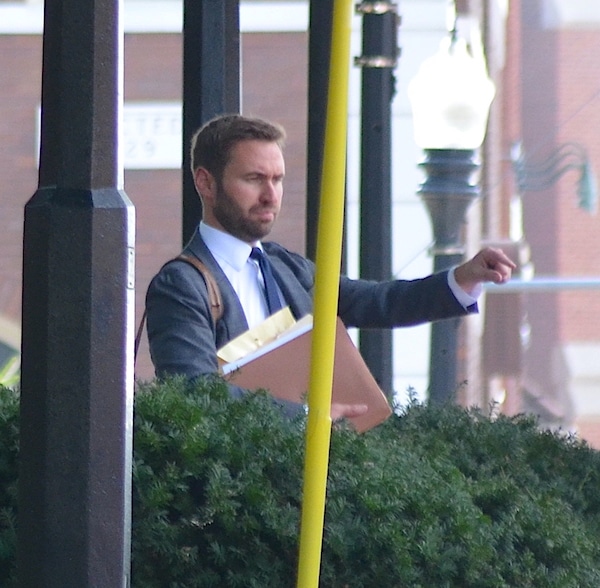Roider trial ends second day

Thanks to DNA testing, ballistics and a detailed autopsy, the jury on Thursday gained a technical look into Steven Becker’s death during the second day of testimony in the trial of Kyle Roider at the Monroe County Courthouse. And with that, the prosecution rests.
Roider, 33, is facing charges of first-degree murder using a firearm and aggravated battery in Becker’s January 2019 death.
Becker’s cause of death, a gunshot wound to the head, was described in detail on Thursday, with testimony from a medical examiner and deputy coroner. The results of DNA and blood testing were also brought to light, along with the role technology played in the case.
Becker’s body was found Jan. 11, 2019, in the basement of the house Roider was inhabiting at 107 N. Church Street in Waterloo. As the Republic-Times reported of Wednesday’s court proceedings, the prosecution and defense both acknowledged days elapsed between the alleged murder and when Becker’s body was discovered.
Ann Rudloff, Monroe County deputy coroner, was called to the stand by the prosecution on Thursday, further confirming this. Becker suffered two gunshot wounds, as an autopsy later confirmed, with the head wound creating a large pool of blood. Rudloff said Becker was found stuck to the floor due to the blood drying.
Dr. Kamal Sabharwal, a medical examiner, then testified. He said during defense cross examination that the first gunshot to Becker’s leg may not have caused him to be immobile, but the head shot would have incapacitated him.

Along with pictures put on the screen by Monroe County State’s Attorney Lucas Liefer, Sabharwal described the fatal gunshot to the head. As pictures and narration showed, this gunshot left an entry wound on the left side of Becker’s face and an exit wound in the back of his head. Because the wound in the back of Becker’s head did not have any abrasion, Sabharwal concluded it was an exit wound, he told the jury.
Sabharwal introduced a new buzzword to the jury: “stippling.” As he detailed in both questioning and cross examination, stippling is gunpowder residue burnt into the skin, seen in gunshot wounds where the victim is in close range to the weapon. He told the jury that stippling does, in part, rely on the specific firearm, but one can typically see stippling when the gun was up to 2-4 feet away from the flesh.
During cross examination, Sabharwal said the stippling seen with the head wound led him to believe the gun was level with Becker’s head. At this point, Matthes told the court Becker and Roider, who he had stand up from his seat in the courtroom, were just one inch apart in height.

Matthes used the proposed angle of the shot, along with it being close range, to justify his defense that Becker was first threatening Roider while sitting in a chair sharpening a knife, was then shot in the leg, then charged at Roider, at which point Roider fired the fatal shot.
Becker’s leg wound did not show stippling, and Sabharwal testified one could not determine the position Becker was in when shot in the leg.
The toxicology report showed Becker had methamphetamine, cocaine and marijuana in his system at the time of his death. Sabharwal said these drugs and their combination can impact people in different ways, yet said “it is possible” when Matthes asked if they could make Becker unstable or “blood-thirsty.”
Sabharwal gave the same response when asked if the combination of substances could produce a compound effect.
The conclusions of witnesses Keia Tate, a forensic biologist with the Illinois State Police, and Meredith Misker from the ISP Forensics Science Lab worked hand-in-hand. Tate determined the red blood-like substance on the TV stand first mentioned Wednesday was in fact blood. She then sent swabs of this substance to Misker’s lab for DNA analysis.
In two separate reports, Misker’s testing determined the swab from the projectile showed Becker can be included as a “contributor,” but Roider’s DNA was excluded. The DNA analysis from the TV stand included Becker as a contributor, and excluded Roider.
Essentially, there is a high probability Becker’s DNA is on the projectile and it’s his blood on the TV stand.
Testimony from Waterloo Police Department Detective Eric Zaber, who is still on the force, and Brian Koberna, who has been in charge of the Madison County forensic lab for two years now, showed the jury how technology could play into their verdict.
Zaber responded to a medical call over the scanner on Jan. 11, 2019. When he arrived on scene, he was informed Becker’s body was in Roider’s basement. He conducted a sweep of the house and later collected the phones of Roider, Becker, Jennifer McClure and her friend who had been hanging out with the trio shortly before Becker’s death.
Roider, and his phone, were at McClure’s house; the phone was seized at the time he was arrested, the cross examination revealed. What was missing, however, was Roider’s schizophrenia medication, the cross-examination revealed.
Koberna then extracted data from Becker’s and Roider’s phones. He testified he could only do a logical extraction from Becker’s phone, meaning the data he could extract and parce was limited. Data from Jan 9, 2019, the day the shooting allegedly took place, only showed incoming calls and corresponding phone numbers. Under questioning from the prosecution, Koberna said the fact there were missing entries showed some data was deleted, but there was no way of knowing who erased the data – which included texts between Becker and his daughter.
Waterloo police, Koberna believed, with the help of the FBI, obtained a physical extraction of data from Roider’s phone. This is essentially the “best case scenario” for investigators, as this type of extraction even contains deleted data.
Liefer entered every record of every cellular communication made on Roider’s phone in the time frame from the day of the alleged offense to the day Becker’s body was discovered into evidence.
A Facebook post mentioned in court Wednesday, which Matthes said Roider made after the murder while trying “to clear his head,” was shown on the screen for jurors to view.
The quote read, “Before action one must understand the cause, because without true understanding there is no real meaning. Understanding is true knowledge.”
This post was an image of the quote, Koberna confirmed.
Near the end of Thursday’s proceedings, Matthes patted Roider on the back. Similar to Wednesday’s proceedings, Roider greeted family and friends seated in the gallery with smiles. He remained attentive while witnesses took the stand and was dressed in a fresh dress suit,
The prosecution rested it case and the jury was dismissed early Thursday afternoon with a reminder to not discuss the case with anyone. Judge Julia Gomric told them they would meet again at 8:30 a.m. Friday.
For a recap of the first day of this trial, click here.
UPDATE: On Aug. 27, 2021, a Monroe County jury found Kyle Roider not guilty of first-degree murder and not guilty of aggravated battery with a firearm. These charges were brought against Roider in connection with Steven Becker’s January 2019 death.






